In Egyptian history, the Upper and Lower Egypt period was the final stage of prehistoric Egypt and directly preceded the unification of the realm. The conception of Egypt as the Two Lands was an example of the dualism in ancient Egyptian culture and frequently appeared in texts and imagery, including in the titles of Egyptian pharaohs.

Thoth is an ancient Egyptian deity. In art, he was often depicted as a man with the head of an ibis or a baboon, animals sacred to him. His feminine counterpart was Seshat, and his wife was Ma'at. He was the god of the moon, wisdom, writing, hieroglyphs, science, magic, art, and judgment. His Greek equivalent is Hermes.

Nut, also known by various other transcriptions, is the goddess of the sky, stars, cosmos, mothers, astronomy, and the universe in the ancient Egyptian religion. She was seen as a star-covered nude woman arching over the Earth, or as a cow. She was depicted wearing the water-pot sign (nw) that identifies her.
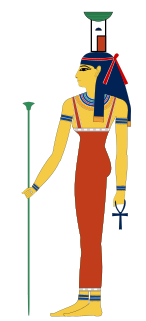
Nephthys or Nebet-Het in ancient Egyptian was a goddess in ancient Egyptian religion. A member of the Great Ennead of Heliopolis in Egyptian mythology, she was a daughter of Nut and Geb. Nephthys was typically paired with her sister Isis in funerary rites because of their role as protectors of the mummy and the god Osiris and as the sister-wife of Set.
Duamutef was, in ancient Egyptian religion, one of the four sons of Horus and a protection god of the canopic jars. Commonly he is said to be the son of the god Horus the Elder. Another myth describes Duamutef and his brothers as sons of Osiris. According to this account, they were born from a lily flower which arose from the primaeval ocean.
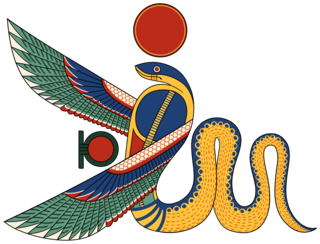
Wadjet, known to the Greek world as Uto or Buto among other renderings including Wedjat, Uadjet, and Udjo, was originally the ancient local goddess of the city of Dep. It became part of the city that the Egyptians named Per-Wadjet and the Greeks called Buto, which was an important site in prehistoric Egypt and the cultural developments of the Paleolithic. There was also a Per-Wadjet in Upper Egypt.
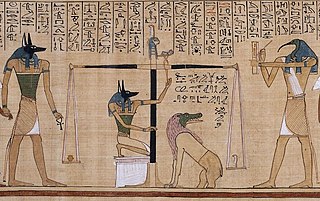
The Book of the Dead is an ancient Egyptian funerary text generally written on papyrus and used from the beginning of the New Kingdom to around 50 BCE. The original Egyptian name for the text, transliterated rw nw prt m hrw, is translated as Book of Coming Forth by Day or Book of Emerging Forth into the Light. "Book" is the closest term to describe the loose collection of texts consisting of a number of magic spells intended to assist a dead person's journey through the Duat, or underworld, and into the afterlife and written by many priests over a period of about 1,000 years. Karl Richard Lepsius introduced for these texts the German name Todtenbuch, translated to English as Book of the Dead.

Canopic jars are containers that were used by the ancient Egyptians during the mummification process, to store and preserve the viscera of their owner for the afterlife. They were commonly either carved from limestone, or were made of pottery. These jars were used by the ancient Egyptians from the time of the Old Kingdom, until the time of the Late Period or the Ptolemaic Period, by which time the viscera were simply wrapped and placed with the body. The viscera were not kept in a single canopic jar: each jar was reserved for specific organs. The term canopic reflects the mistaken association by early Egyptologists with the Greek legend of Canopus – the boat captain of Menelaus on the voyage to Troy – "who was buried at Canopus in the Delta where he was worshipped in the form of a jar". In alternative versions, the name derives from the location Canopus in the western Nile Delta near Alexandria, where human-headed jars were worshipped as personifications of the god Osiris.

The Eye of Horus, wedjat eye or udjat eye is a concept and symbol in ancient Egyptian religion that represents well-being, healing, and protection. It derives from the mythical conflict between the god Horus with his rival Set, in which Set tore out or destroyed one or both of Horus's eyes and the eye was subsequently healed or returned to Horus with the assistance of another deity, such as Thoth. Horus subsequently offered the eye to his deceased father Osiris, and its revitalizing power sustained Osiris in the afterlife. The Eye of Horus was thus equated with funerary offerings, as well as with all the offerings given to deities in temple ritual. It could also represent other concepts, such as the moon, whose waxing and waning was likened to the injury and restoration of the eye.
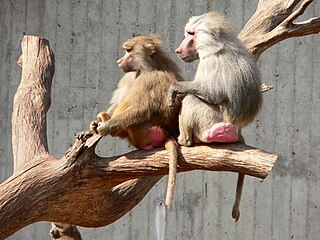
The hamadryas baboon is a species of baboon within the Old World monkey family. It is the northernmost of all the baboons, being native to the Horn of Africa and the southwestern region of the Arabian Peninsula. These regions provide habitats with the advantage for this species of fewer natural predators than central or southern Africa where other baboons reside. The hamadryas baboon was a sacred animal to the ancient Egyptians and appears in various roles in ancient Egyptian religion, hence its alternative name of 'sacred baboon'.

Sitre or Tia-Sitre, was the Great Royal Wife of Pharaoh Ramesses I of Egypt and mother of Seti I.
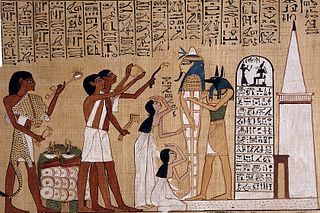
The ancient Egyptians had an elaborate set of funerary practices that they believed were necessary to ensure their immortality after death. These rituals included mummifying the body, casting magic spells, and burials with specific grave goods thought to be needed in the afterlife.

The Coffin Texts are a collection of ancient Egyptian funerary spells written on coffins beginning in the First Intermediate Period. They are partially derived from the earlier Pyramid Texts, reserved for royal use only, but contain substantial new material related to everyday desires, indicating a new target audience of common people. Coffin texts are dated back to 2100 BCE. Ordinary Egyptians who could afford a coffin had access to these funerary spells and the pharaoh no longer had exclusive rights to an afterlife.

The Pyramid Texts are the oldest ancient Egyptian funerary texts, dating to the late Old Kingdom. They are the earliest known corpus of ancient Egyptian religious texts. Written in Old Egyptian, the pyramid texts were carved onto the subterranean walls and sarcophagi of pyramids at Saqqara from the end of the Fifth Dynasty, and throughout the Sixth Dynasty of the Old Kingdom, and into the Eighth Dynasty of the First Intermediate Period.

The four sons of Horus were a group of four gods in ancient Egyptian religion, who were essentially the personifications of the four canopic jars, which accompanied mummified bodies. Since the heart was thought to embody the soul, it was left inside the body. The brain was thought only to be the origin of mucus, so it was reduced to liquid, removed with metal hooks, and discarded. This left the stomach, liver, large intestines, and lungs, which were removed, embalmed and stored, each organ in its own jar. There were times when embalmers deviated from this scheme: during the 21st Dynasty they embalmed and wrapped the viscera and returned them to the body, while the canopic jars remained empty symbols.

Qebehsenuef is an ancient Egyptian deity. He is one of the four sons of Horus in Egyptian mythology, the god of protection and of the West. In the preparation of mummies, his canopic jar was used for the intestines. He is seen as a mummy with a falcon head. He was said to be protected by the goddess Serket. The intestine was used in sacrificed animals, by soothsayers, to predict the future, whereas the intestines were also the victims of poison. With death by poison, the canopic jar deity is protected by Serket, who bears the emblem of the scorpion:
[Qebhsennuf saith:] "I am thy son, O Osiris Ani, triumphant. I have come to protect thee. I have collected thy bones, and I have gathered together thy members. I have brought thy heart and I have placed it upon its throne within thy body. I have made thy house to flourish after thee, O thou who livest for ever.
In ancient Egyptian religion, Aani is the dog-headed ape sacred to the Egyptian god Thoth. "One of the Egyptian names of the Cynocephalus Baboon, which was sacred to the god Thoth."
The Egyptian Book of the Dead of Qenna is a papyrus document housed at the Dutch National Museum of Antiquities in Leiden. One of several thousand papyri containing material drawn from Book of the Dead funerary texts, Qenna uniquely includes a passage that describes a deceased person’s activity in an afterlife location it calls the “house of hearts.” While the house of hearts is mentioned in at least two tomb inscriptions, Qenna treats it in more detail. The passage appears as an addendum within Spell 151 of the Book of the Dead:
"You will enter the house of hearts, the place which is full of hearts. You will take the one that is yours and put it in its place, without your hand being hindered. Your foot will not be stopped from walking. You will not walk upside down. You will walk upright."
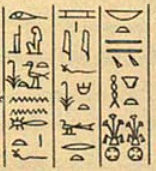
QV75 is the tomb of Henutmire, likely the daughter and Great Wife of Ramesses II, in Egypt's Valley of the Queens. It was mentioned by Champollion and Lepsius.

















